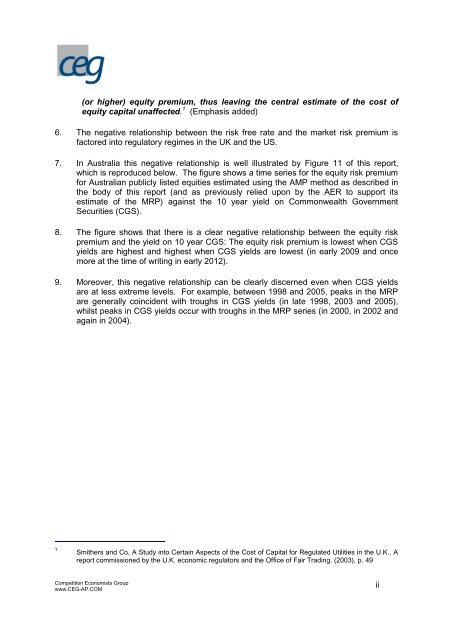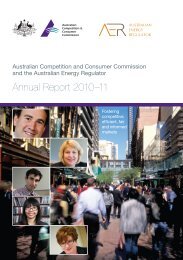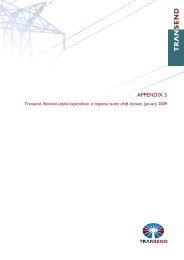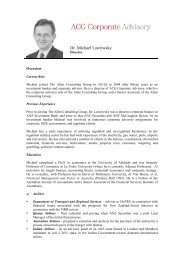Internal consistency of risk free rate and MRP in the CAPM
Internal consistency of risk free rate and MRP in the CAPM
Internal consistency of risk free rate and MRP in the CAPM
You also want an ePaper? Increase the reach of your titles
YUMPU automatically turns print PDFs into web optimized ePapers that Google loves.
(or higher) equity premium, thus leav<strong>in</strong>g <strong>the</strong> central estimate <strong>of</strong> <strong>the</strong> cost <strong>of</strong><br />
equity capital unaffected. 1 (Emphasis added)<br />
6. The negative relationship between <strong>the</strong> <strong>risk</strong> <strong>free</strong> <strong>rate</strong> <strong>and</strong> <strong>the</strong> market <strong>risk</strong> premium is<br />
factored <strong>in</strong>to regulatory regimes <strong>in</strong> <strong>the</strong> UK <strong>and</strong> <strong>the</strong> US.<br />
7. In Australia this negative relationship is well illust<strong>rate</strong>d by Figure 11 <strong>of</strong> this report,<br />
which is reproduced below. The figure shows a time series for <strong>the</strong> equity <strong>risk</strong> premium<br />
for Australian publicly listed equities estimated us<strong>in</strong>g <strong>the</strong> AMP method as described <strong>in</strong><br />
<strong>the</strong> body <strong>of</strong> this report (<strong>and</strong> as previously relied upon by <strong>the</strong> AER to support its<br />
estimate <strong>of</strong> <strong>the</strong> <strong>MRP</strong>) aga<strong>in</strong>st <strong>the</strong> 10 year yield on Commonwealth Government<br />
Securities (CGS).<br />
8. The figure shows that <strong>the</strong>re is a clear negative relationship between <strong>the</strong> equity <strong>risk</strong><br />
premium <strong>and</strong> <strong>the</strong> yield on 10 year CGS: The equity <strong>risk</strong> premium is lowest when CGS<br />
yields are highest <strong>and</strong> highest when CGS yields are lowest (<strong>in</strong> early 2009 <strong>and</strong> once<br />
more at <strong>the</strong> time <strong>of</strong> writ<strong>in</strong>g <strong>in</strong> early 2012).<br />
9. Moreover, this negative relationship can be clearly discerned even when CGS yields<br />
are at less extreme levels. For example, between 1998 <strong>and</strong> 2005, peaks <strong>in</strong> <strong>the</strong> <strong>MRP</strong><br />
are generally co<strong>in</strong>cident with troughs <strong>in</strong> CGS yields (<strong>in</strong> late 1998, 2003 <strong>and</strong> 2005),<br />
whilst peaks <strong>in</strong> CGS yields occur with troughs <strong>in</strong> <strong>the</strong> <strong>MRP</strong> series (<strong>in</strong> 2000, <strong>in</strong> 2002 <strong>and</strong><br />
aga<strong>in</strong> <strong>in</strong> 2004).<br />
1 Smi<strong>the</strong>rs <strong>and</strong> Co, A Study <strong>in</strong>to Certa<strong>in</strong> Aspects <strong>of</strong> <strong>the</strong> Cost <strong>of</strong> Capital for Regulated Utilities <strong>in</strong> <strong>the</strong> U.K., A<br />
report commissioned by <strong>the</strong> U.K. economic regulators <strong>and</strong> <strong>the</strong> Office <strong>of</strong> Fair Trad<strong>in</strong>g. (2003), p. 49<br />
Competition Economists Group<br />
www.CEG-AP.COM<br />
ii







